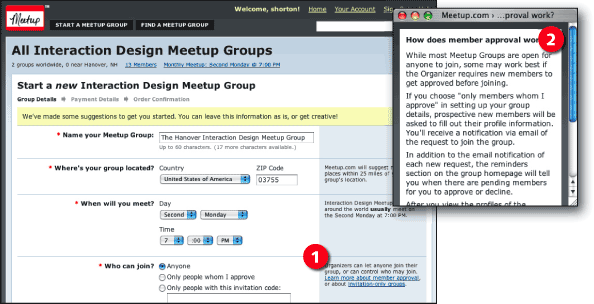Interactivity
Allow users to control the user interface
Some interactive formats allow designers to take control of the user interface to a much greater extent than with HTML alone. Designers can modify the environment by opening new windows, resizing and repositioning windows, hiding browser toolbars, and moving the cursor focus (Figure 13.3). These functions are ordinarily part of the user’s domain and so are defined by the user. When a page performs these functions on behalf of the user, usability suffers. Users may be disoriented by this new and inconsistent browser behavior, and the modifications may not fit users’ needs.

Figure 13.3: Meetup provides help information (1) in small, auxiliary windows without navigation, status, or other standard browser toolbars (2). www.meetup.com
For instance, designers can use JavaScript to open a new window, set its size and position, and determine which browser elements display—menus, toolbars, status bar, and so on. The new window can be defined as fixed or resizable. The user cannot override these settings. For example, if a designer uses JavaScript to open a page in a small, fixed-size window, users who need large type will be forced to scroll and to read a narrow text column.
Another common technique is to move cursor focus from the top of the page, as is customary, to the search text input field. This action is based on the assumption that users want to search and that they will appreciate having the cursor in position to enter a query. Users who expect to access Web content starting at the top of the page—particularly people who use the keyboard to navigate, and those who use screen reader software—will be disoriented if the cursor is anywhere but at the top of the page.
Designers implement these functions for the sake of usability—to make Web use easier and more efficient. However, we need to recognize and respect the boundary surrounding the user’s domain. The Web allows users to make decisions about their environment based on their needs and preferences. We can make Web use easier and more efficient for more users if we stick with conventional Web behaviors and allow users to control their own environment.

